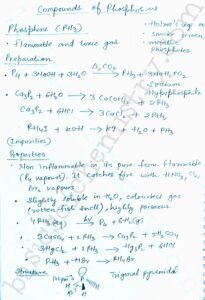PHOSPHINE GAS PH3 PREPARATION PROPERTIES AND USES
Here in this article you will study about the phosphine gas PH3 preparation, properties and uses. You can also download the PDF notes for phosphine gas PH3 preparation properties and uses. For complete information on phosphine gas PH3 visit the YouTube video
Notes on Phosphine gas PH3 preparation properties and uses
Phosphine gas PH3 preparation properties and uses
Preparation of phosphine gas PH3
Phosphine gas is a flammable and toxic gas. It can be easily prepared in the laboratory by heating white phosphorus with concentrated sodium hydroxide solution in the inert atmosphere of CO2.
The Phosphine gas is also prepared by the reaction of calcium phosphide with water or dilute HCl.
Properties of phosphine gas PH3
Phosphine gas is non inflammable in its pure form but it becomes inflammable because of the presence of P4 vapours. The Phosphine gas catches fire when it comes in the contact of strong oxidising agents like HNO3 and also traces of chlorine and bromine vapours.
The Phosphine gas is slightly soluble in water. Phosphine gas is a colourless gas but highly poisonous as it smells like rotten fish.
PH3 is weakly basic like Ammonia and it reacts with acid to form phosphonium compounds.
The phosphine gas is absorbed in copper sulphate solution or mercuric chloride solution to form the corresponding phosphide salts.
Solution of phosphine in water decomposes in the presence of light giving red phosphorus and hydrogen gas.
Structure of phosphine gas PH3
Phosphine gas is a triangle Pyramid in shape. Due to the presence of lone pair the bond length of P -H is 142 pm. Lone pair present on Phosphorus atom in phosphine gas causes H-P-H bond angle to 93.5 degrees.
Applications or uses of phosphine gas PH3
Phosphine gas is used to create smoke screens phosphine gas is also used for making metallic phosphides.
The major application of of first find gas is used on the fact of it spontaneous combustion which is used as Holme’s signal.
For the latest updates you can join –
Website – https://basicsofchemistry.com/
Instagram – https://www.instagram.com/monabindalgupta/
Facebook – https://www.facebook.com/monabindalgupta/
Twitter – https://twitter.com/monabindalgupta
Quora – https://www.quora.com/profile/Mona-Gupta-202
LinkedIn – https://www.linkedin.com/in/mona-gupta-7b450519a

